Business Decision Making Analysis Report - MBA Assignment
VerifiedAdded on 2023/06/13
|11
|2195
|52
Report
AI Summary
This report provides an analysis of business decision-making at Ademark Business Training and Consulting, focusing on both strategic and operational levels. The report identifies the nature of problems encountered, distinguishing between tame and wicked problems, and examines the approaches used for decision-making, assessing whether they are qualitative or quantitative. It evaluates the decision-making processes against Williams' rational problem-solving approach, highlighting the consequences of not following each step and the obstacles encountered. The report includes recommendations for decision-makers at various levels within the organization, based on theoretical frameworks and practical insights. The strategic issues include franchise renewal versus cancellation, while operational issues involve the need for digital training. The analysis incorporates tools like SMART to address these challenges and proposes solutions based on partnership and online training, balancing quantitative and qualitative considerations for effective problem-solving.
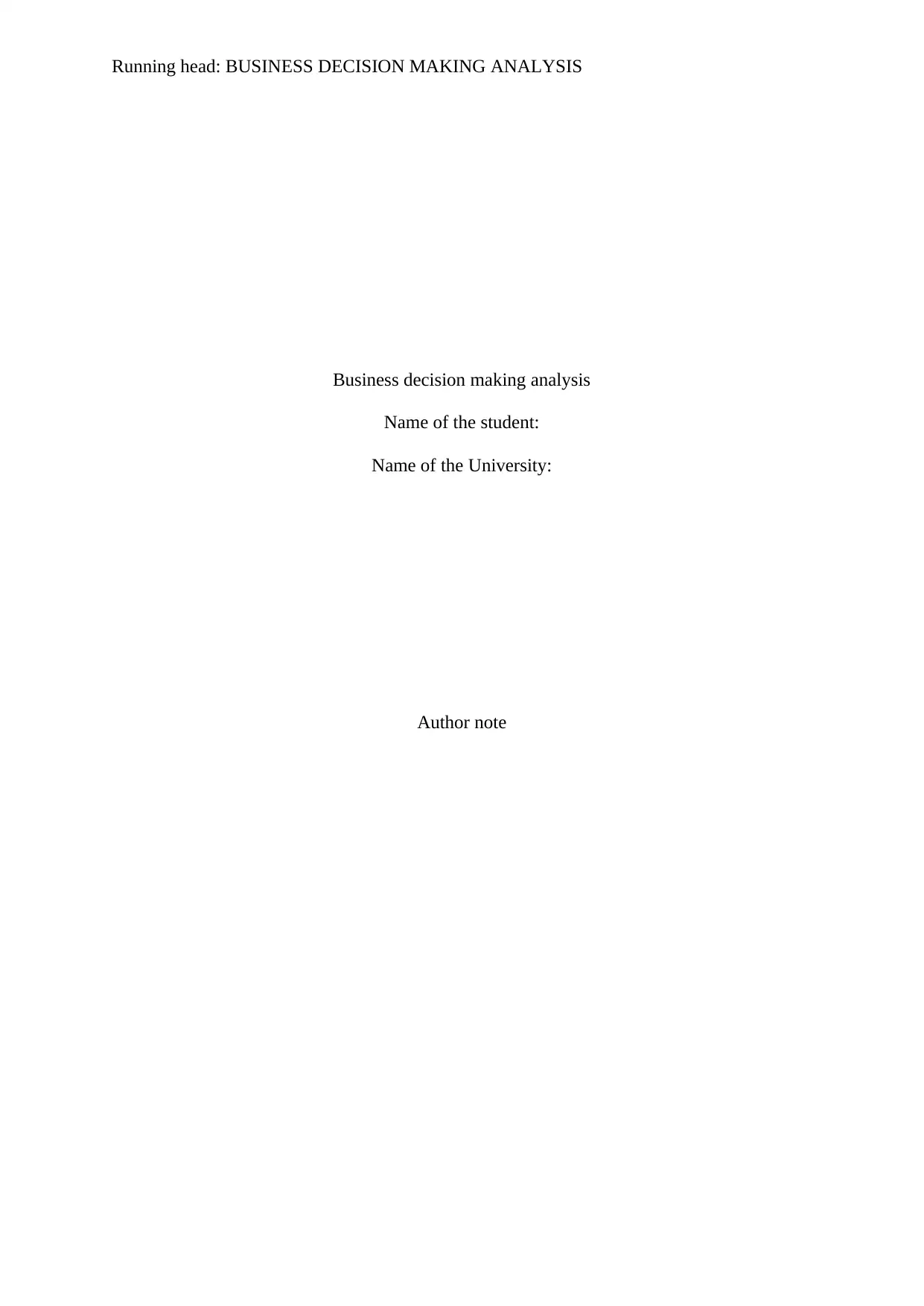
Running head: BUSINESS DECISION MAKING ANALYSIS
Business decision making analysis
Name of the student:
Name of the University:
Author note
Business decision making analysis
Name of the student:
Name of the University:
Author note
Paraphrase This Document
Need a fresh take? Get an instant paraphrase of this document with our AI Paraphraser
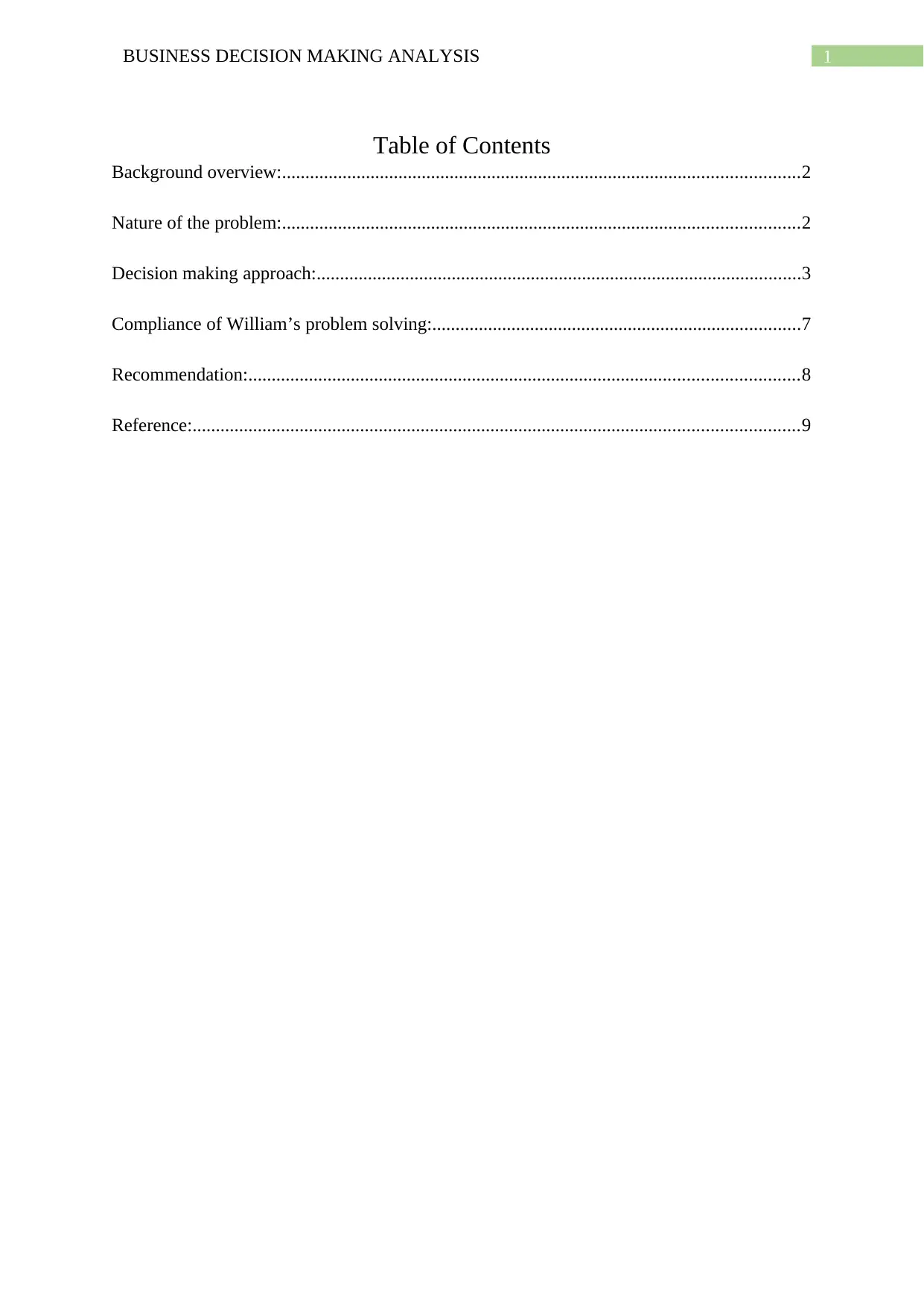
1BUSINESS DECISION MAKING ANALYSIS
Table of Contents
Background overview:...............................................................................................................2
Nature of the problem:...............................................................................................................2
Decision making approach:........................................................................................................3
Compliance of William’s problem solving:...............................................................................7
Recommendation:......................................................................................................................8
Reference:..................................................................................................................................9
Table of Contents
Background overview:...............................................................................................................2
Nature of the problem:...............................................................................................................2
Decision making approach:........................................................................................................3
Compliance of William’s problem solving:...............................................................................7
Recommendation:......................................................................................................................8
Reference:..................................................................................................................................9
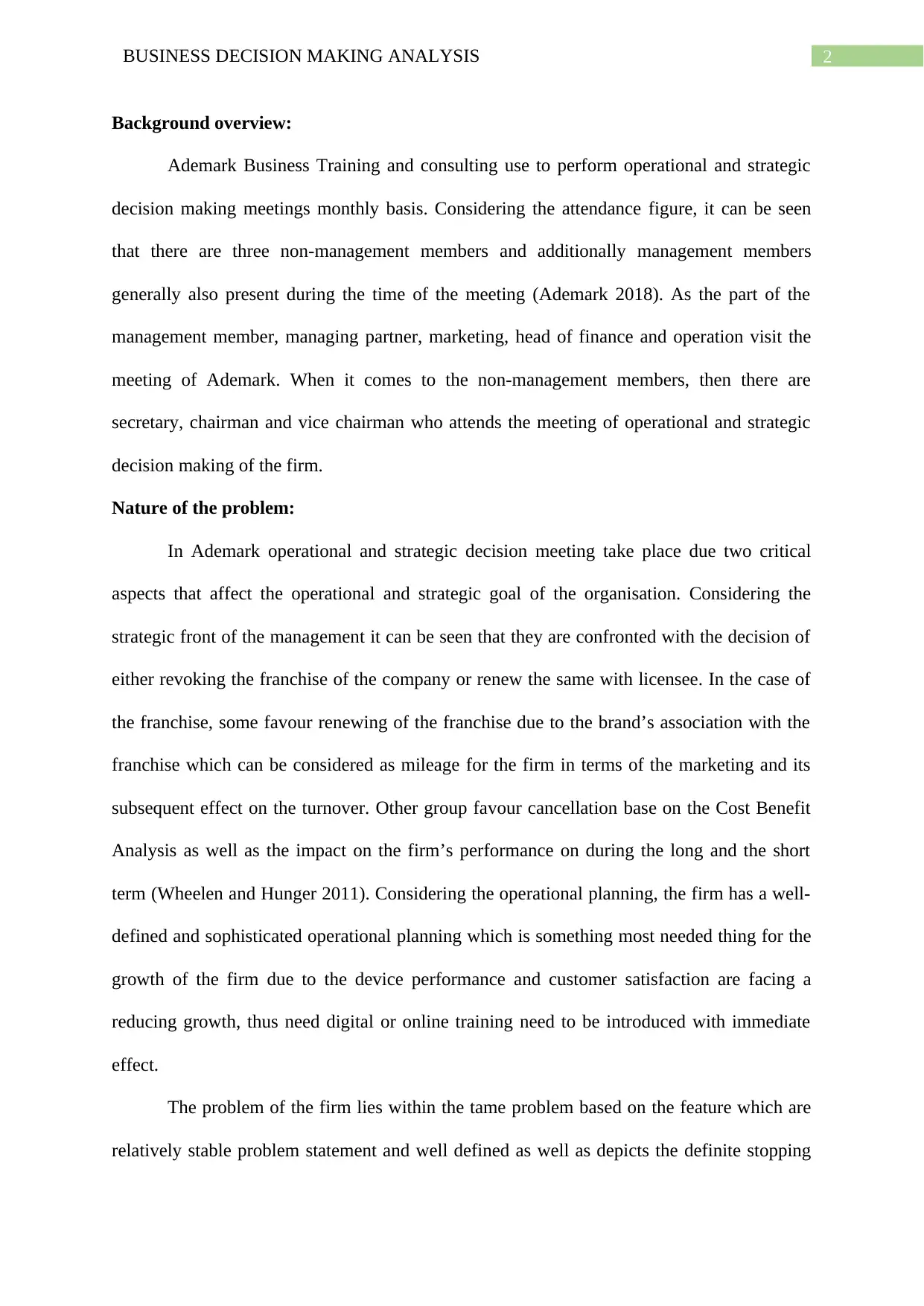
2BUSINESS DECISION MAKING ANALYSIS
Background overview:
Ademark Business Training and consulting use to perform operational and strategic
decision making meetings monthly basis. Considering the attendance figure, it can be seen
that there are three non-management members and additionally management members
generally also present during the time of the meeting (Ademark 2018). As the part of the
management member, managing partner, marketing, head of finance and operation visit the
meeting of Ademark. When it comes to the non-management members, then there are
secretary, chairman and vice chairman who attends the meeting of operational and strategic
decision making of the firm.
Nature of the problem:
In Ademark operational and strategic decision meeting take place due two critical
aspects that affect the operational and strategic goal of the organisation. Considering the
strategic front of the management it can be seen that they are confronted with the decision of
either revoking the franchise of the company or renew the same with licensee. In the case of
the franchise, some favour renewing of the franchise due to the brand’s association with the
franchise which can be considered as mileage for the firm in terms of the marketing and its
subsequent effect on the turnover. Other group favour cancellation base on the Cost Benefit
Analysis as well as the impact on the firm’s performance on during the long and the short
term (Wheelen and Hunger 2011). Considering the operational planning, the firm has a well-
defined and sophisticated operational planning which is something most needed thing for the
growth of the firm due to the device performance and customer satisfaction are facing a
reducing growth, thus need digital or online training need to be introduced with immediate
effect.
The problem of the firm lies within the tame problem based on the feature which are
relatively stable problem statement and well defined as well as depicts the definite stopping
Background overview:
Ademark Business Training and consulting use to perform operational and strategic
decision making meetings monthly basis. Considering the attendance figure, it can be seen
that there are three non-management members and additionally management members
generally also present during the time of the meeting (Ademark 2018). As the part of the
management member, managing partner, marketing, head of finance and operation visit the
meeting of Ademark. When it comes to the non-management members, then there are
secretary, chairman and vice chairman who attends the meeting of operational and strategic
decision making of the firm.
Nature of the problem:
In Ademark operational and strategic decision meeting take place due two critical
aspects that affect the operational and strategic goal of the organisation. Considering the
strategic front of the management it can be seen that they are confronted with the decision of
either revoking the franchise of the company or renew the same with licensee. In the case of
the franchise, some favour renewing of the franchise due to the brand’s association with the
franchise which can be considered as mileage for the firm in terms of the marketing and its
subsequent effect on the turnover. Other group favour cancellation base on the Cost Benefit
Analysis as well as the impact on the firm’s performance on during the long and the short
term (Wheelen and Hunger 2011). Considering the operational planning, the firm has a well-
defined and sophisticated operational planning which is something most needed thing for the
growth of the firm due to the device performance and customer satisfaction are facing a
reducing growth, thus need digital or online training need to be introduced with immediate
effect.
The problem of the firm lies within the tame problem based on the feature which are
relatively stable problem statement and well defined as well as depicts the definite stopping
⊘ This is a preview!⊘
Do you want full access?
Subscribe today to unlock all pages.

Trusted by 1+ million students worldwide
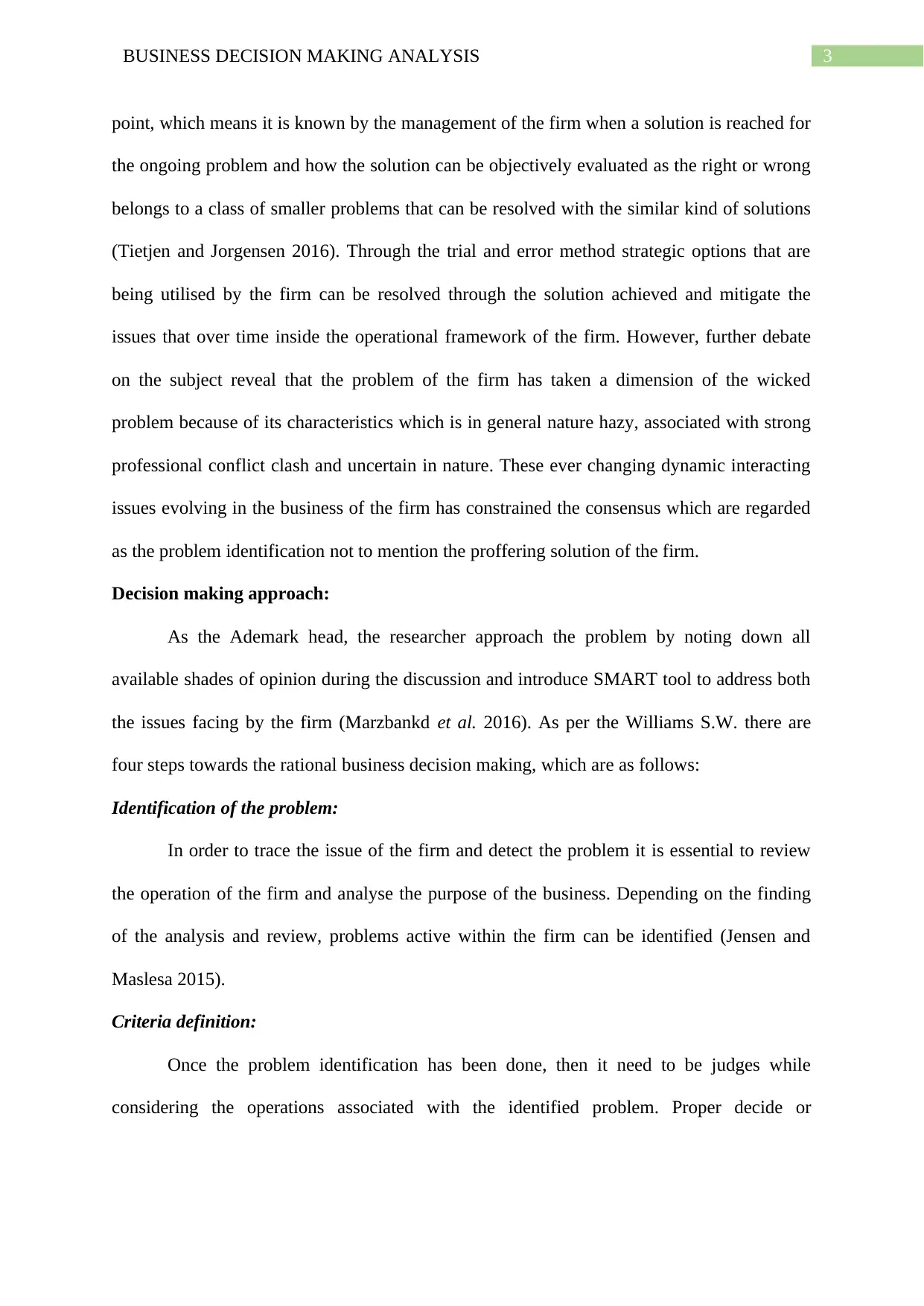
3BUSINESS DECISION MAKING ANALYSIS
point, which means it is known by the management of the firm when a solution is reached for
the ongoing problem and how the solution can be objectively evaluated as the right or wrong
belongs to a class of smaller problems that can be resolved with the similar kind of solutions
(Tietjen and Jorgensen 2016). Through the trial and error method strategic options that are
being utilised by the firm can be resolved through the solution achieved and mitigate the
issues that over time inside the operational framework of the firm. However, further debate
on the subject reveal that the problem of the firm has taken a dimension of the wicked
problem because of its characteristics which is in general nature hazy, associated with strong
professional conflict clash and uncertain in nature. These ever changing dynamic interacting
issues evolving in the business of the firm has constrained the consensus which are regarded
as the problem identification not to mention the proffering solution of the firm.
Decision making approach:
As the Ademark head, the researcher approach the problem by noting down all
available shades of opinion during the discussion and introduce SMART tool to address both
the issues facing by the firm (Marzbankd et al. 2016). As per the Williams S.W. there are
four steps towards the rational business decision making, which are as follows:
Identification of the problem:
In order to trace the issue of the firm and detect the problem it is essential to review
the operation of the firm and analyse the purpose of the business. Depending on the finding
of the analysis and review, problems active within the firm can be identified (Jensen and
Maslesa 2015).
Criteria definition:
Once the problem identification has been done, then it need to be judges while
considering the operations associated with the identified problem. Proper decide or
point, which means it is known by the management of the firm when a solution is reached for
the ongoing problem and how the solution can be objectively evaluated as the right or wrong
belongs to a class of smaller problems that can be resolved with the similar kind of solutions
(Tietjen and Jorgensen 2016). Through the trial and error method strategic options that are
being utilised by the firm can be resolved through the solution achieved and mitigate the
issues that over time inside the operational framework of the firm. However, further debate
on the subject reveal that the problem of the firm has taken a dimension of the wicked
problem because of its characteristics which is in general nature hazy, associated with strong
professional conflict clash and uncertain in nature. These ever changing dynamic interacting
issues evolving in the business of the firm has constrained the consensus which are regarded
as the problem identification not to mention the proffering solution of the firm.
Decision making approach:
As the Ademark head, the researcher approach the problem by noting down all
available shades of opinion during the discussion and introduce SMART tool to address both
the issues facing by the firm (Marzbankd et al. 2016). As per the Williams S.W. there are
four steps towards the rational business decision making, which are as follows:
Identification of the problem:
In order to trace the issue of the firm and detect the problem it is essential to review
the operation of the firm and analyse the purpose of the business. Depending on the finding
of the analysis and review, problems active within the firm can be identified (Jensen and
Maslesa 2015).
Criteria definition:
Once the problem identification has been done, then it need to be judges while
considering the operations associated with the identified problem. Proper decide or
Paraphrase This Document
Need a fresh take? Get an instant paraphrase of this document with our AI Paraphraser
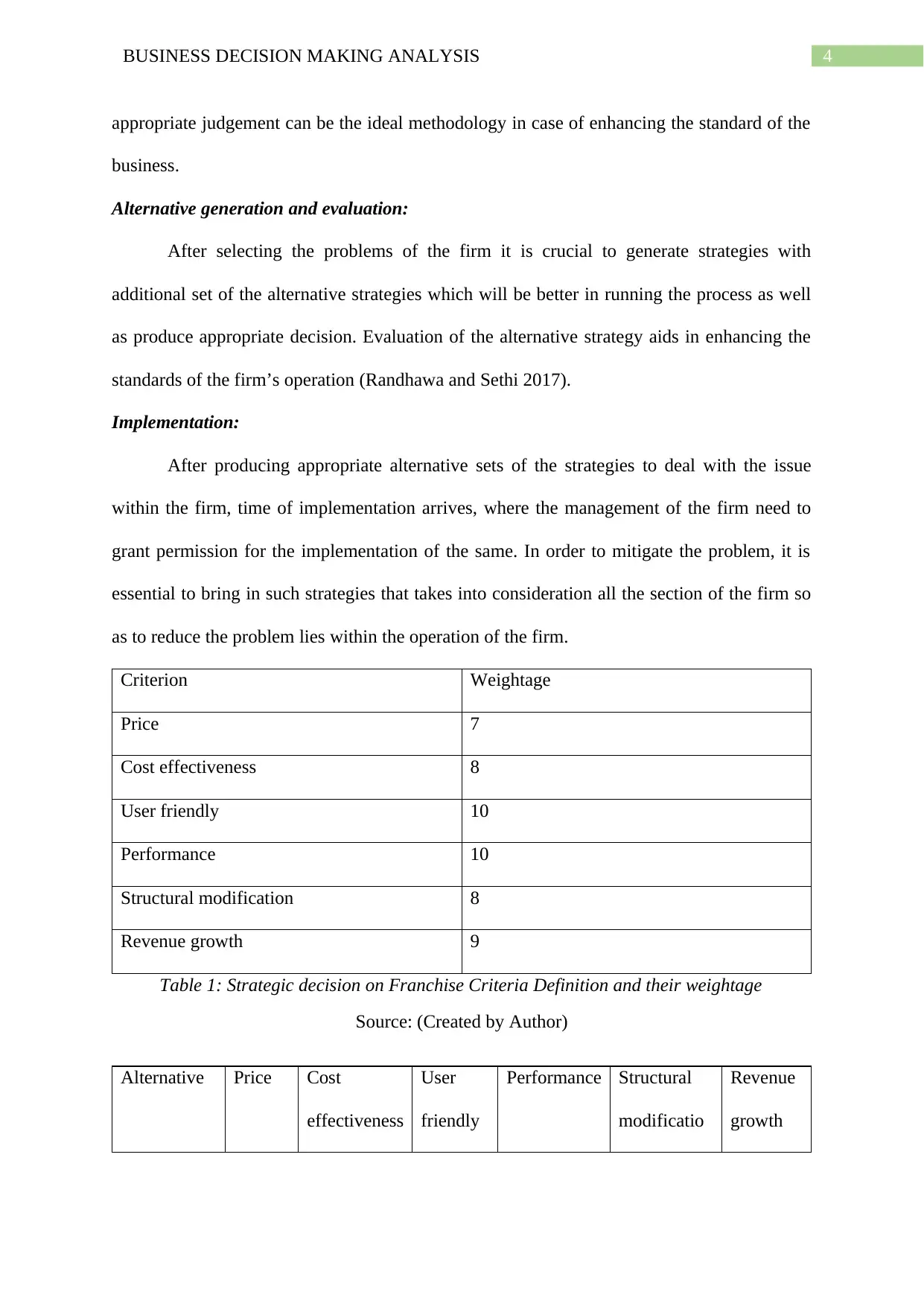
4BUSINESS DECISION MAKING ANALYSIS
appropriate judgement can be the ideal methodology in case of enhancing the standard of the
business.
Alternative generation and evaluation:
After selecting the problems of the firm it is crucial to generate strategies with
additional set of the alternative strategies which will be better in running the process as well
as produce appropriate decision. Evaluation of the alternative strategy aids in enhancing the
standards of the firm’s operation (Randhawa and Sethi 2017).
Implementation:
After producing appropriate alternative sets of the strategies to deal with the issue
within the firm, time of implementation arrives, where the management of the firm need to
grant permission for the implementation of the same. In order to mitigate the problem, it is
essential to bring in such strategies that takes into consideration all the section of the firm so
as to reduce the problem lies within the operation of the firm.
Criterion Weightage
Price 7
Cost effectiveness 8
User friendly 10
Performance 10
Structural modification 8
Revenue growth 9
Table 1: Strategic decision on Franchise Criteria Definition and their weightage
Source: (Created by Author)
Alternative Price Cost
effectiveness
User
friendly
Performance Structural
modificatio
Revenue
growth
appropriate judgement can be the ideal methodology in case of enhancing the standard of the
business.
Alternative generation and evaluation:
After selecting the problems of the firm it is crucial to generate strategies with
additional set of the alternative strategies which will be better in running the process as well
as produce appropriate decision. Evaluation of the alternative strategy aids in enhancing the
standards of the firm’s operation (Randhawa and Sethi 2017).
Implementation:
After producing appropriate alternative sets of the strategies to deal with the issue
within the firm, time of implementation arrives, where the management of the firm need to
grant permission for the implementation of the same. In order to mitigate the problem, it is
essential to bring in such strategies that takes into consideration all the section of the firm so
as to reduce the problem lies within the operation of the firm.
Criterion Weightage
Price 7
Cost effectiveness 8
User friendly 10
Performance 10
Structural modification 8
Revenue growth 9
Table 1: Strategic decision on Franchise Criteria Definition and their weightage
Source: (Created by Author)
Alternative Price Cost
effectiveness
User
friendly
Performance Structural
modificatio
Revenue
growth
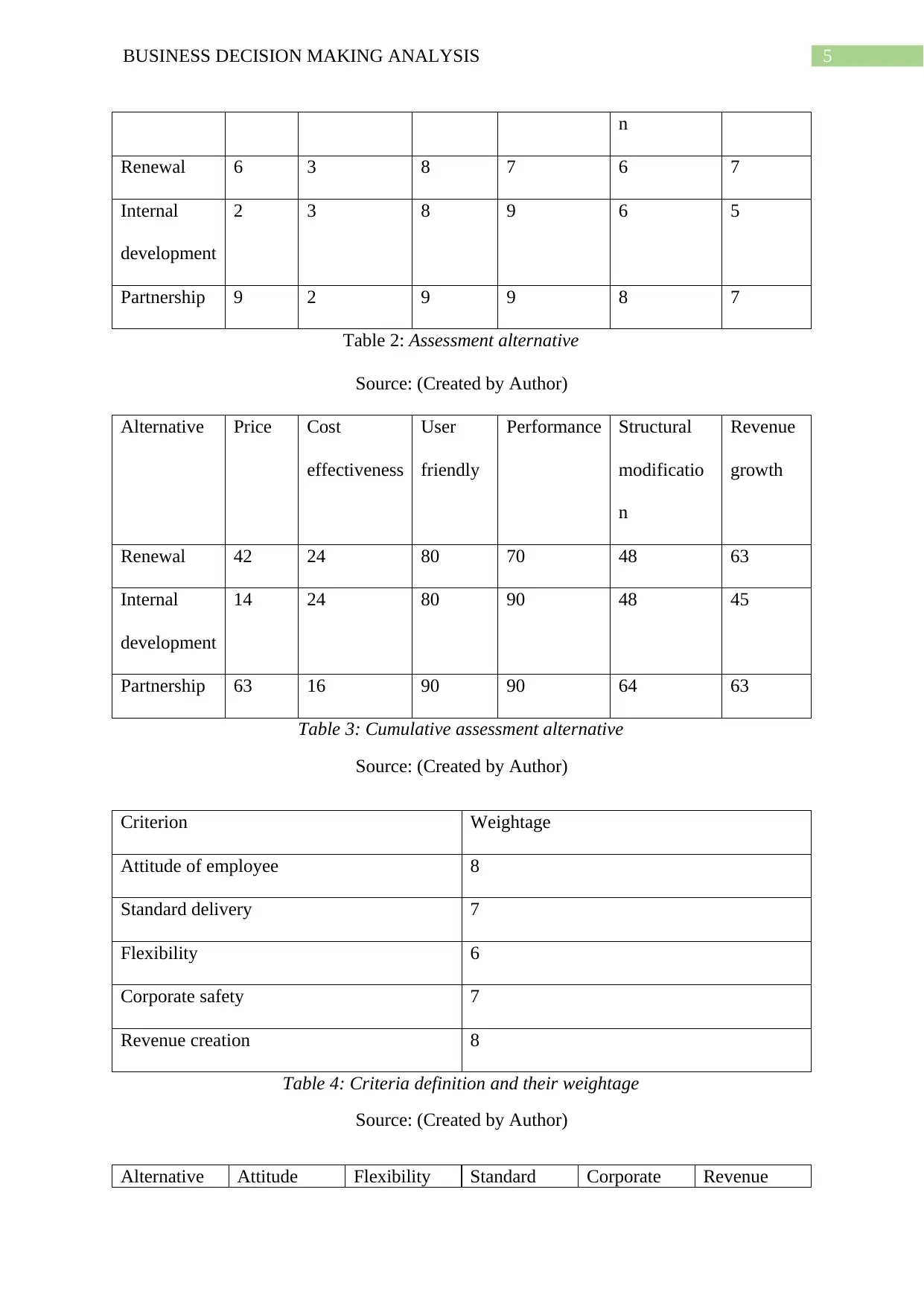
5BUSINESS DECISION MAKING ANALYSIS
n
Renewal 6 3 8 7 6 7
Internal
development
2 3 8 9 6 5
Partnership 9 2 9 9 8 7
Table 2: Assessment alternative
Source: (Created by Author)
Alternative Price Cost
effectiveness
User
friendly
Performance Structural
modificatio
n
Revenue
growth
Renewal 42 24 80 70 48 63
Internal
development
14 24 80 90 48 45
Partnership 63 16 90 90 64 63
Table 3: Cumulative assessment alternative
Source: (Created by Author)
Criterion Weightage
Attitude of employee 8
Standard delivery 7
Flexibility 6
Corporate safety 7
Revenue creation 8
Table 4: Criteria definition and their weightage
Source: (Created by Author)
Alternative Attitude Flexibility Standard Corporate Revenue
n
Renewal 6 3 8 7 6 7
Internal
development
2 3 8 9 6 5
Partnership 9 2 9 9 8 7
Table 2: Assessment alternative
Source: (Created by Author)
Alternative Price Cost
effectiveness
User
friendly
Performance Structural
modificatio
n
Revenue
growth
Renewal 42 24 80 70 48 63
Internal
development
14 24 80 90 48 45
Partnership 63 16 90 90 64 63
Table 3: Cumulative assessment alternative
Source: (Created by Author)
Criterion Weightage
Attitude of employee 8
Standard delivery 7
Flexibility 6
Corporate safety 7
Revenue creation 8
Table 4: Criteria definition and their weightage
Source: (Created by Author)
Alternative Attitude Flexibility Standard Corporate Revenue
⊘ This is a preview!⊘
Do you want full access?
Subscribe today to unlock all pages.

Trusted by 1+ million students worldwide
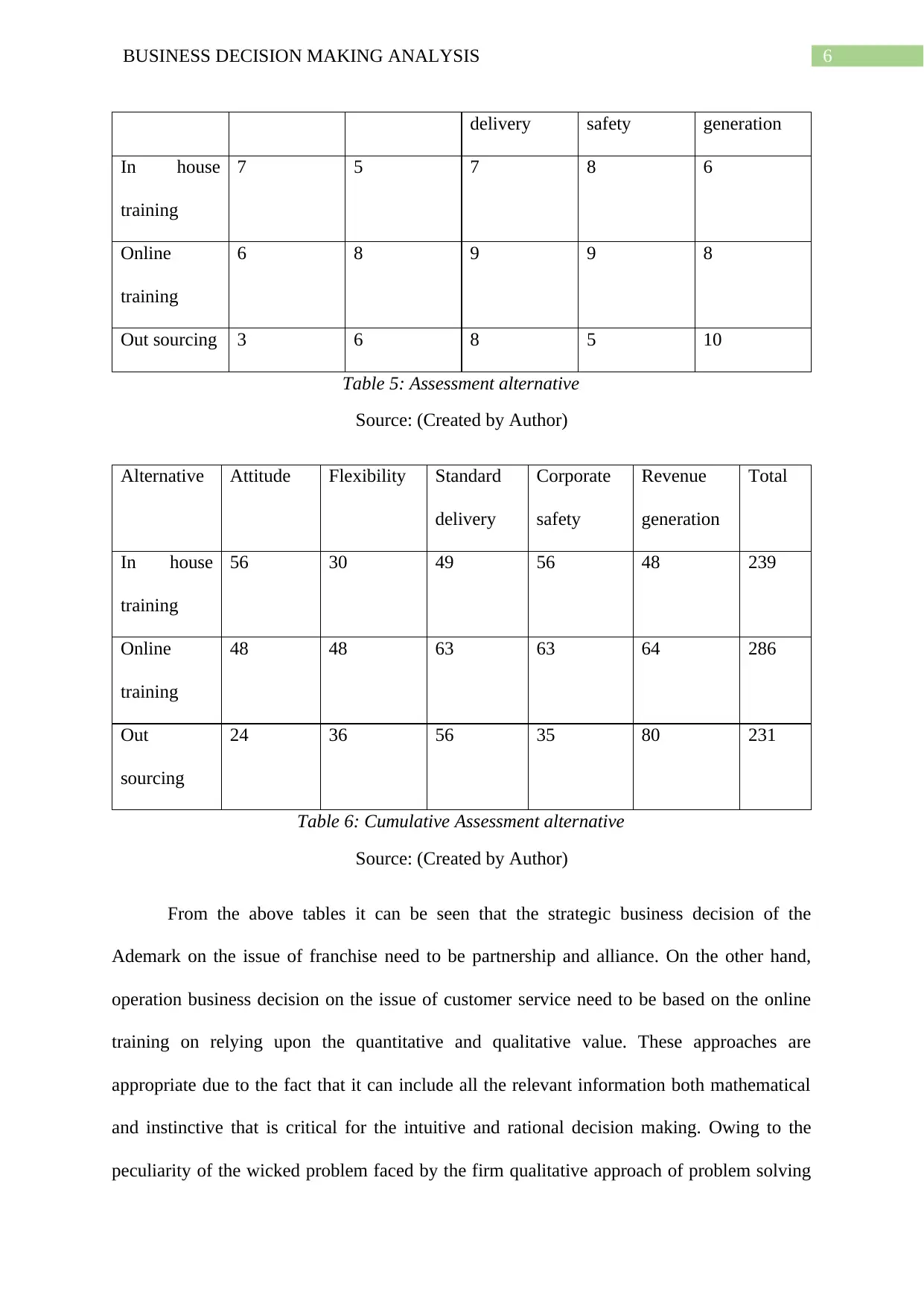
6BUSINESS DECISION MAKING ANALYSIS
delivery safety generation
In house
training
7 5 7 8 6
Online
training
6 8 9 9 8
Out sourcing 3 6 8 5 10
Table 5: Assessment alternative
Source: (Created by Author)
Alternative Attitude Flexibility Standard
delivery
Corporate
safety
Revenue
generation
Total
In house
training
56 30 49 56 48 239
Online
training
48 48 63 63 64 286
Out
sourcing
24 36 56 35 80 231
Table 6: Cumulative Assessment alternative
Source: (Created by Author)
From the above tables it can be seen that the strategic business decision of the
Ademark on the issue of franchise need to be partnership and alliance. On the other hand,
operation business decision on the issue of customer service need to be based on the online
training on relying upon the quantitative and qualitative value. These approaches are
appropriate due to the fact that it can include all the relevant information both mathematical
and instinctive that is critical for the intuitive and rational decision making. Owing to the
peculiarity of the wicked problem faced by the firm qualitative approach of problem solving
delivery safety generation
In house
training
7 5 7 8 6
Online
training
6 8 9 9 8
Out sourcing 3 6 8 5 10
Table 5: Assessment alternative
Source: (Created by Author)
Alternative Attitude Flexibility Standard
delivery
Corporate
safety
Revenue
generation
Total
In house
training
56 30 49 56 48 239
Online
training
48 48 63 63 64 286
Out
sourcing
24 36 56 35 80 231
Table 6: Cumulative Assessment alternative
Source: (Created by Author)
From the above tables it can be seen that the strategic business decision of the
Ademark on the issue of franchise need to be partnership and alliance. On the other hand,
operation business decision on the issue of customer service need to be based on the online
training on relying upon the quantitative and qualitative value. These approaches are
appropriate due to the fact that it can include all the relevant information both mathematical
and instinctive that is critical for the intuitive and rational decision making. Owing to the
peculiarity of the wicked problem faced by the firm qualitative approach of problem solving
Paraphrase This Document
Need a fresh take? Get an instant paraphrase of this document with our AI Paraphraser
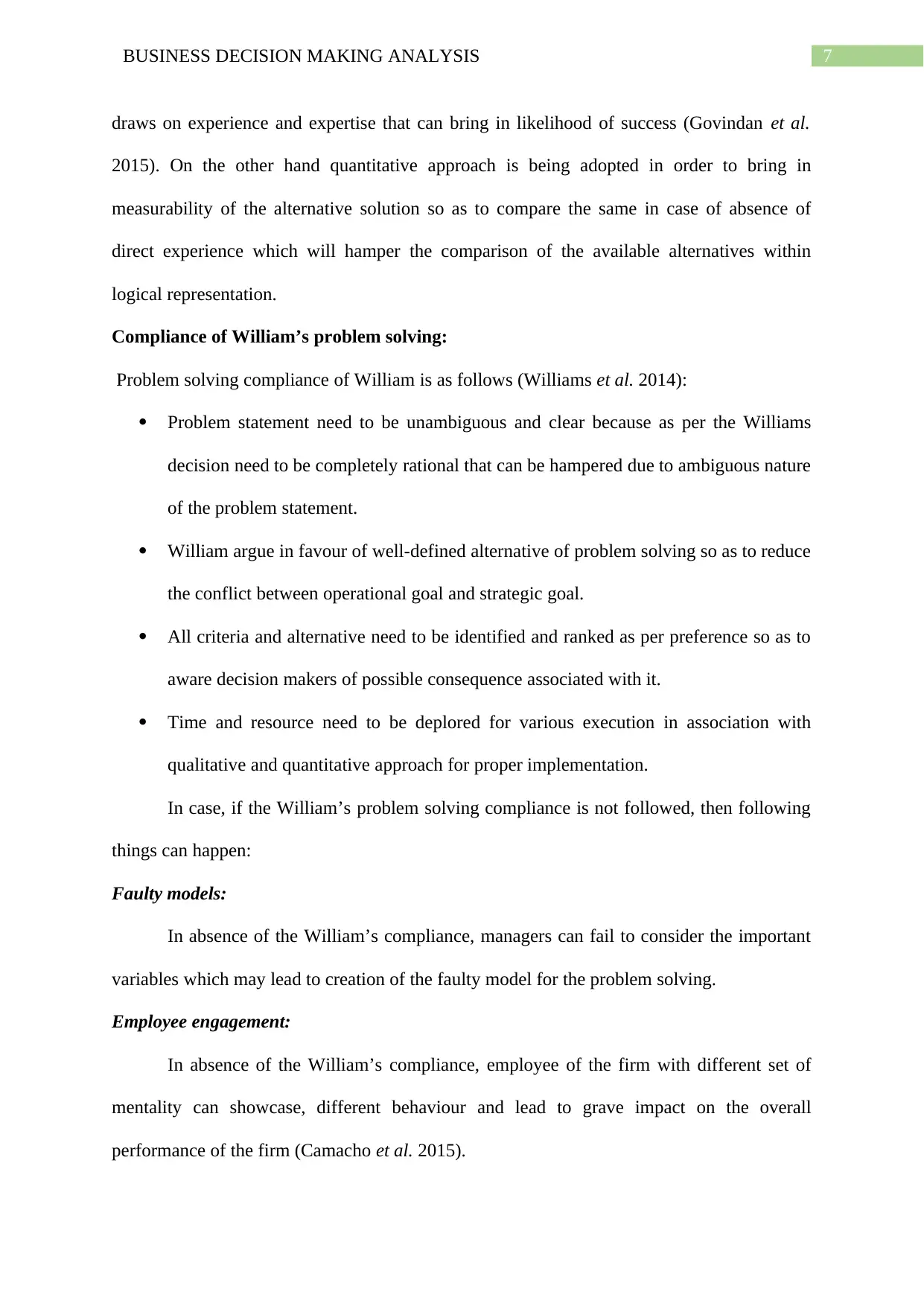
7BUSINESS DECISION MAKING ANALYSIS
draws on experience and expertise that can bring in likelihood of success (Govindan et al.
2015). On the other hand quantitative approach is being adopted in order to bring in
measurability of the alternative solution so as to compare the same in case of absence of
direct experience which will hamper the comparison of the available alternatives within
logical representation.
Compliance of William’s problem solving:
Problem solving compliance of William is as follows (Williams et al. 2014):
Problem statement need to be unambiguous and clear because as per the Williams
decision need to be completely rational that can be hampered due to ambiguous nature
of the problem statement.
William argue in favour of well-defined alternative of problem solving so as to reduce
the conflict between operational goal and strategic goal.
All criteria and alternative need to be identified and ranked as per preference so as to
aware decision makers of possible consequence associated with it.
Time and resource need to be deplored for various execution in association with
qualitative and quantitative approach for proper implementation.
In case, if the William’s problem solving compliance is not followed, then following
things can happen:
Faulty models:
In absence of the William’s compliance, managers can fail to consider the important
variables which may lead to creation of the faulty model for the problem solving.
Employee engagement:
In absence of the William’s compliance, employee of the firm with different set of
mentality can showcase, different behaviour and lead to grave impact on the overall
performance of the firm (Camacho et al. 2015).
draws on experience and expertise that can bring in likelihood of success (Govindan et al.
2015). On the other hand quantitative approach is being adopted in order to bring in
measurability of the alternative solution so as to compare the same in case of absence of
direct experience which will hamper the comparison of the available alternatives within
logical representation.
Compliance of William’s problem solving:
Problem solving compliance of William is as follows (Williams et al. 2014):
Problem statement need to be unambiguous and clear because as per the Williams
decision need to be completely rational that can be hampered due to ambiguous nature
of the problem statement.
William argue in favour of well-defined alternative of problem solving so as to reduce
the conflict between operational goal and strategic goal.
All criteria and alternative need to be identified and ranked as per preference so as to
aware decision makers of possible consequence associated with it.
Time and resource need to be deplored for various execution in association with
qualitative and quantitative approach for proper implementation.
In case, if the William’s problem solving compliance is not followed, then following
things can happen:
Faulty models:
In absence of the William’s compliance, managers can fail to consider the important
variables which may lead to creation of the faulty model for the problem solving.
Employee engagement:
In absence of the William’s compliance, employee of the firm with different set of
mentality can showcase, different behaviour and lead to grave impact on the overall
performance of the firm (Camacho et al. 2015).
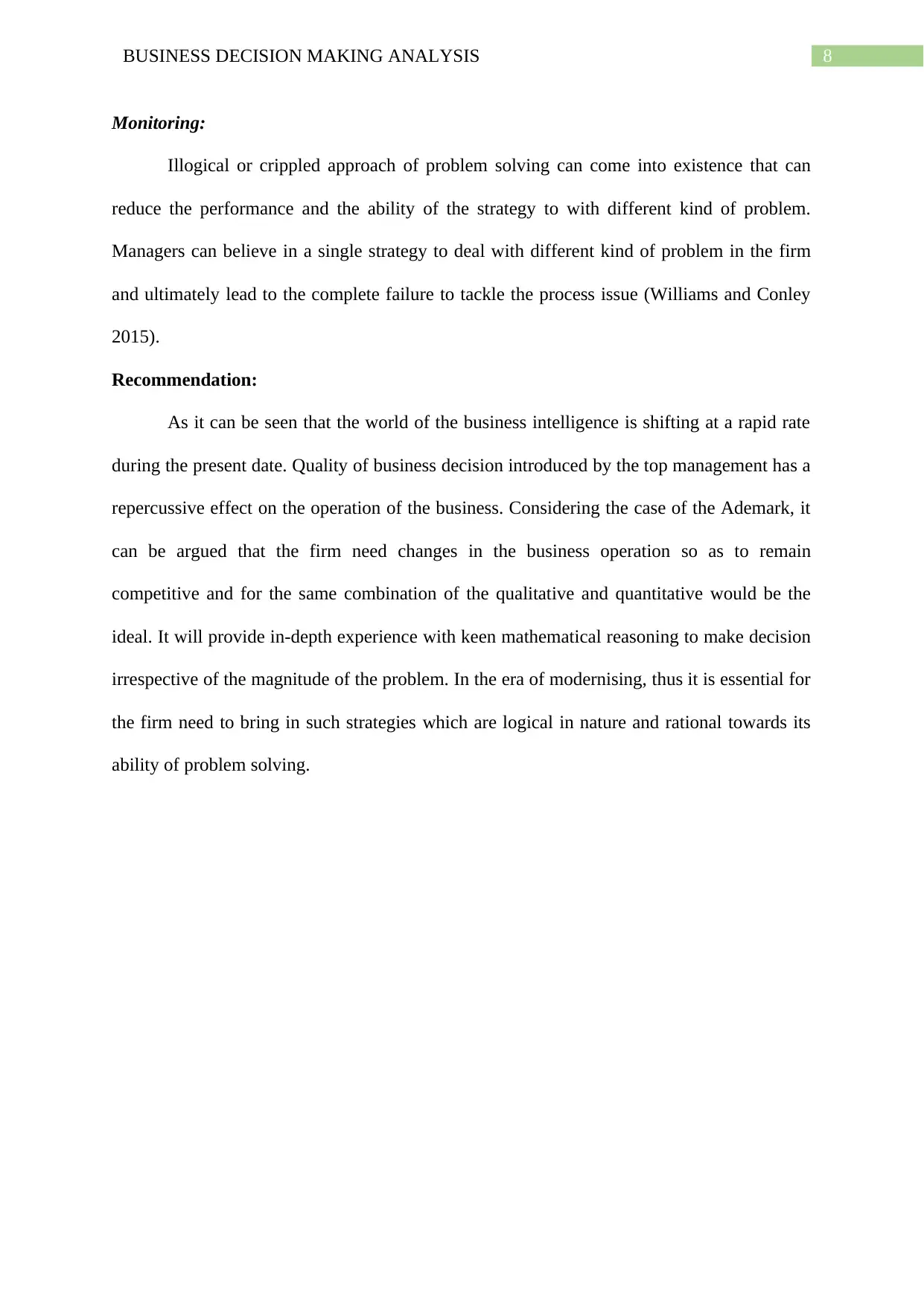
8BUSINESS DECISION MAKING ANALYSIS
Monitoring:
Illogical or crippled approach of problem solving can come into existence that can
reduce the performance and the ability of the strategy to with different kind of problem.
Managers can believe in a single strategy to deal with different kind of problem in the firm
and ultimately lead to the complete failure to tackle the process issue (Williams and Conley
2015).
Recommendation:
As it can be seen that the world of the business intelligence is shifting at a rapid rate
during the present date. Quality of business decision introduced by the top management has a
repercussive effect on the operation of the business. Considering the case of the Ademark, it
can be argued that the firm need changes in the business operation so as to remain
competitive and for the same combination of the qualitative and quantitative would be the
ideal. It will provide in-depth experience with keen mathematical reasoning to make decision
irrespective of the magnitude of the problem. In the era of modernising, thus it is essential for
the firm need to bring in such strategies which are logical in nature and rational towards its
ability of problem solving.
Monitoring:
Illogical or crippled approach of problem solving can come into existence that can
reduce the performance and the ability of the strategy to with different kind of problem.
Managers can believe in a single strategy to deal with different kind of problem in the firm
and ultimately lead to the complete failure to tackle the process issue (Williams and Conley
2015).
Recommendation:
As it can be seen that the world of the business intelligence is shifting at a rapid rate
during the present date. Quality of business decision introduced by the top management has a
repercussive effect on the operation of the business. Considering the case of the Ademark, it
can be argued that the firm need changes in the business operation so as to remain
competitive and for the same combination of the qualitative and quantitative would be the
ideal. It will provide in-depth experience with keen mathematical reasoning to make decision
irrespective of the magnitude of the problem. In the era of modernising, thus it is essential for
the firm need to bring in such strategies which are logical in nature and rational towards its
ability of problem solving.
⊘ This is a preview!⊘
Do you want full access?
Subscribe today to unlock all pages.

Trusted by 1+ million students worldwide
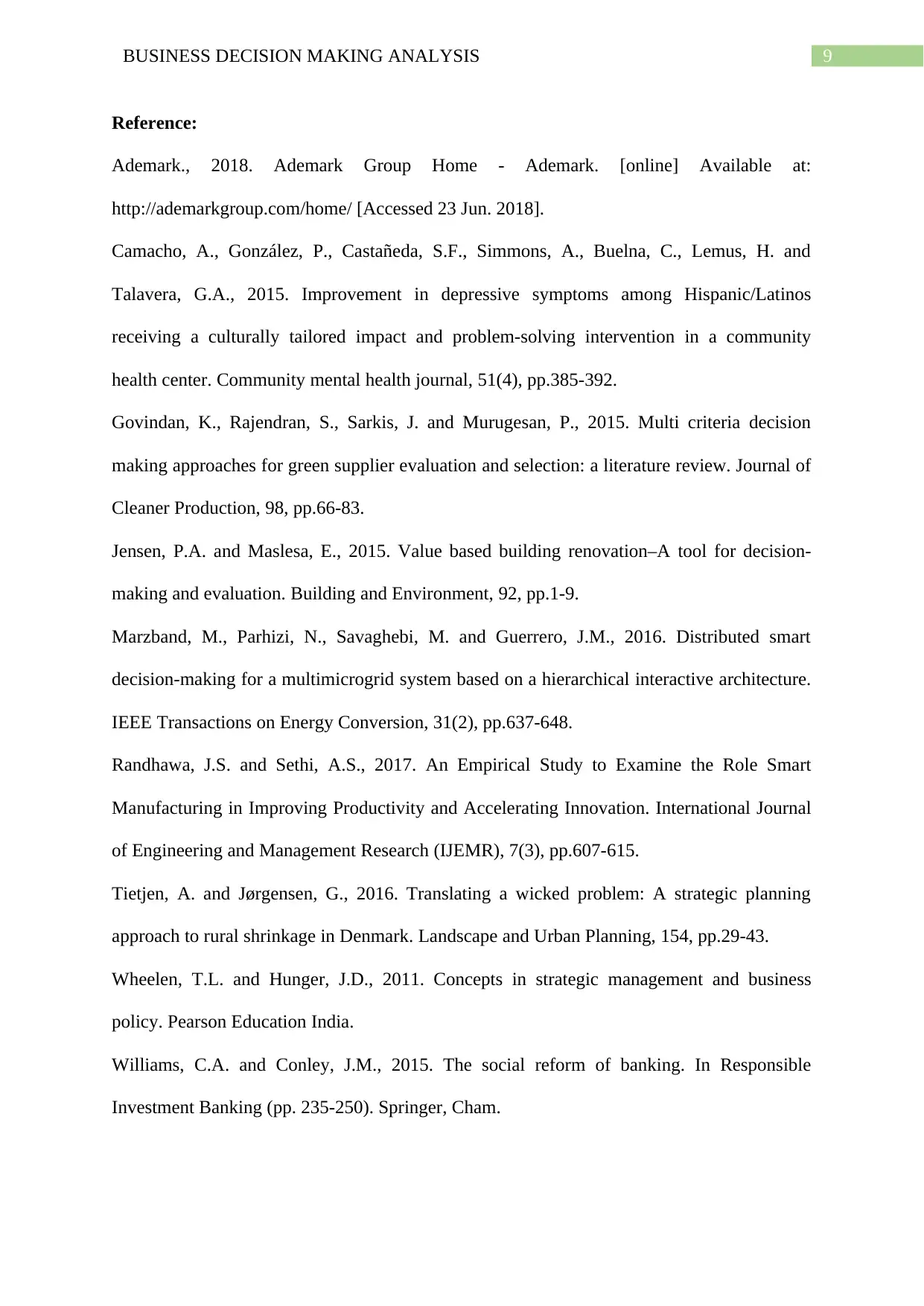
9BUSINESS DECISION MAKING ANALYSIS
Reference:
Ademark., 2018. Ademark Group Home - Ademark. [online] Available at:
http://ademarkgroup.com/home/ [Accessed 23 Jun. 2018].
Camacho, A., González, P., Castañeda, S.F., Simmons, A., Buelna, C., Lemus, H. and
Talavera, G.A., 2015. Improvement in depressive symptoms among Hispanic/Latinos
receiving a culturally tailored impact and problem-solving intervention in a community
health center. Community mental health journal, 51(4), pp.385-392.
Govindan, K., Rajendran, S., Sarkis, J. and Murugesan, P., 2015. Multi criteria decision
making approaches for green supplier evaluation and selection: a literature review. Journal of
Cleaner Production, 98, pp.66-83.
Jensen, P.A. and Maslesa, E., 2015. Value based building renovation–A tool for decision-
making and evaluation. Building and Environment, 92, pp.1-9.
Marzband, M., Parhizi, N., Savaghebi, M. and Guerrero, J.M., 2016. Distributed smart
decision-making for a multimicrogrid system based on a hierarchical interactive architecture.
IEEE Transactions on Energy Conversion, 31(2), pp.637-648.
Randhawa, J.S. and Sethi, A.S., 2017. An Empirical Study to Examine the Role Smart
Manufacturing in Improving Productivity and Accelerating Innovation. International Journal
of Engineering and Management Research (IJEMR), 7(3), pp.607-615.
Tietjen, A. and Jørgensen, G., 2016. Translating a wicked problem: A strategic planning
approach to rural shrinkage in Denmark. Landscape and Urban Planning, 154, pp.29-43.
Wheelen, T.L. and Hunger, J.D., 2011. Concepts in strategic management and business
policy. Pearson Education India.
Williams, C.A. and Conley, J.M., 2015. The social reform of banking. In Responsible
Investment Banking (pp. 235-250). Springer, Cham.
Reference:
Ademark., 2018. Ademark Group Home - Ademark. [online] Available at:
http://ademarkgroup.com/home/ [Accessed 23 Jun. 2018].
Camacho, A., González, P., Castañeda, S.F., Simmons, A., Buelna, C., Lemus, H. and
Talavera, G.A., 2015. Improvement in depressive symptoms among Hispanic/Latinos
receiving a culturally tailored impact and problem-solving intervention in a community
health center. Community mental health journal, 51(4), pp.385-392.
Govindan, K., Rajendran, S., Sarkis, J. and Murugesan, P., 2015. Multi criteria decision
making approaches for green supplier evaluation and selection: a literature review. Journal of
Cleaner Production, 98, pp.66-83.
Jensen, P.A. and Maslesa, E., 2015. Value based building renovation–A tool for decision-
making and evaluation. Building and Environment, 92, pp.1-9.
Marzband, M., Parhizi, N., Savaghebi, M. and Guerrero, J.M., 2016. Distributed smart
decision-making for a multimicrogrid system based on a hierarchical interactive architecture.
IEEE Transactions on Energy Conversion, 31(2), pp.637-648.
Randhawa, J.S. and Sethi, A.S., 2017. An Empirical Study to Examine the Role Smart
Manufacturing in Improving Productivity and Accelerating Innovation. International Journal
of Engineering and Management Research (IJEMR), 7(3), pp.607-615.
Tietjen, A. and Jørgensen, G., 2016. Translating a wicked problem: A strategic planning
approach to rural shrinkage in Denmark. Landscape and Urban Planning, 154, pp.29-43.
Wheelen, T.L. and Hunger, J.D., 2011. Concepts in strategic management and business
policy. Pearson Education India.
Williams, C.A. and Conley, J.M., 2015. The social reform of banking. In Responsible
Investment Banking (pp. 235-250). Springer, Cham.
Paraphrase This Document
Need a fresh take? Get an instant paraphrase of this document with our AI Paraphraser
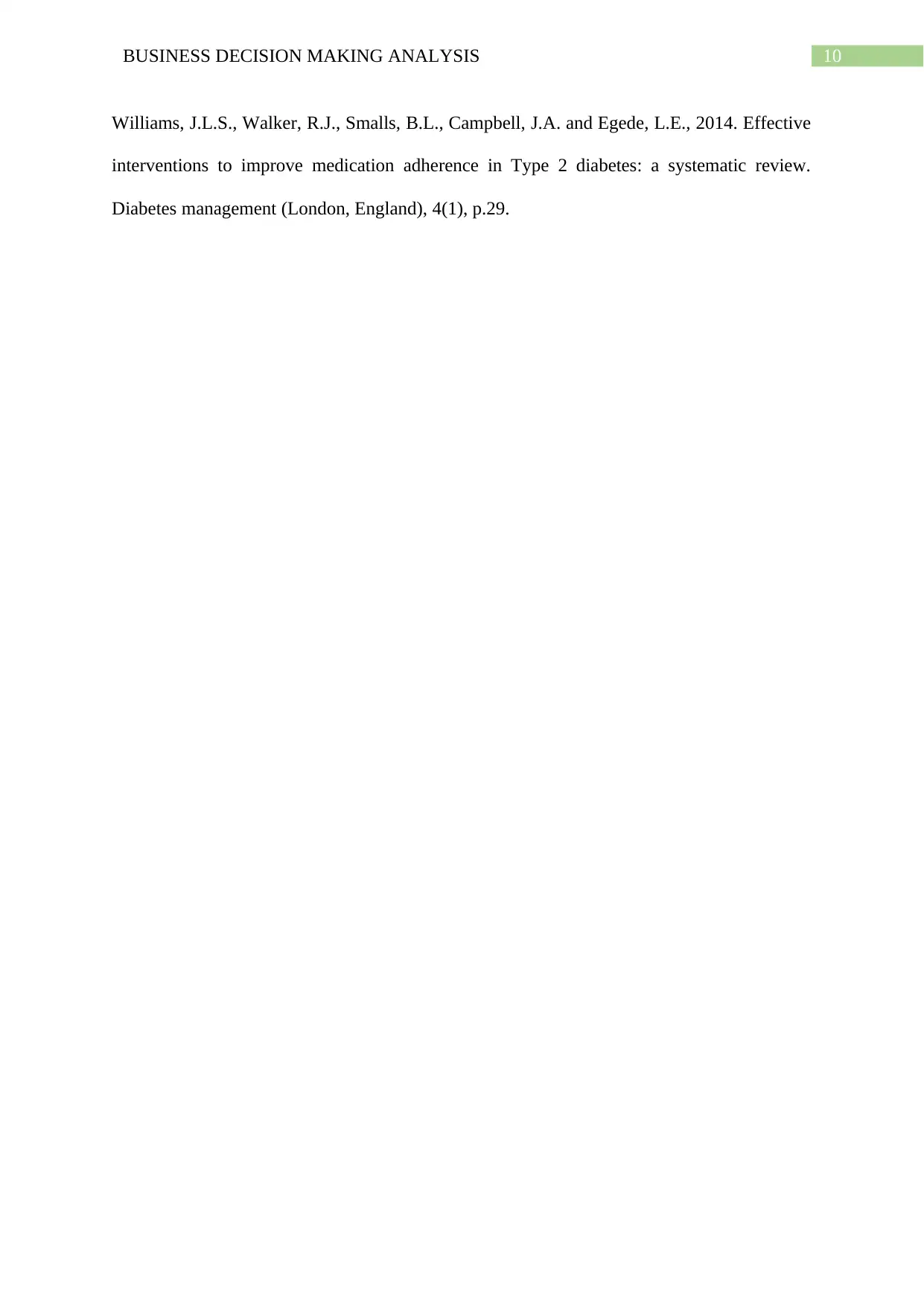
10BUSINESS DECISION MAKING ANALYSIS
Williams, J.L.S., Walker, R.J., Smalls, B.L., Campbell, J.A. and Egede, L.E., 2014. Effective
interventions to improve medication adherence in Type 2 diabetes: a systematic review.
Diabetes management (London, England), 4(1), p.29.
Williams, J.L.S., Walker, R.J., Smalls, B.L., Campbell, J.A. and Egede, L.E., 2014. Effective
interventions to improve medication adherence in Type 2 diabetes: a systematic review.
Diabetes management (London, England), 4(1), p.29.
1 out of 11
Related Documents
Your All-in-One AI-Powered Toolkit for Academic Success.
+13062052269
info@desklib.com
Available 24*7 on WhatsApp / Email
![[object Object]](/_next/static/media/star-bottom.7253800d.svg)
Unlock your academic potential
Copyright © 2020–2025 A2Z Services. All Rights Reserved. Developed and managed by ZUCOL.





